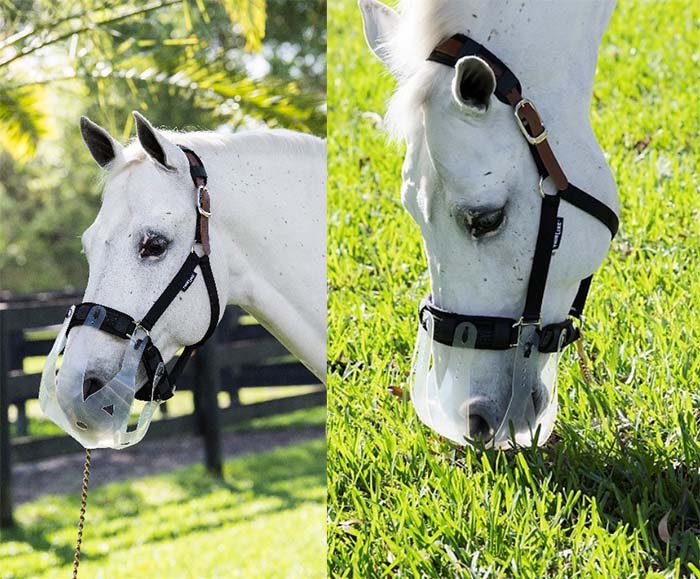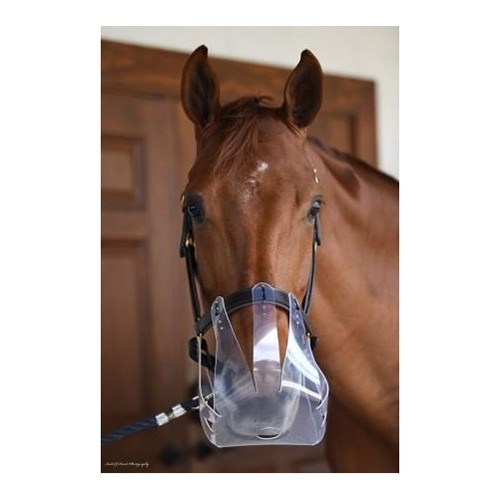
The sun is shining, the birds are chirping, and the grass is growing. For many horse owners, spring has been long awaited. However, for equestrians who care for horses with Insulin Resistance (IR), Cushings, or Equine Metabolic Syndrome (EMS), spring adds another layer of complexity into their daily equine regime.
Help your horse maintain a healthy weight and drastically reduce the amount of grass and feed they can ingest while out on pasture by utilizing a grazing muzzle. These simple pieces of equine equipment prevent your horse from overeating, without impairing their ability to drink water or breathe normally.
The Dangers of Spring
For horses with conditions such as insulin resistance (IR), Cushings, equine metabolic syndrome (EMS), and polysaccharide storage myopathy (PSSM), it is generally recommended by veterinarians that they consume diets low in starch and sugar. New, tender grass growth in the spring contains high levels of non-structural carbohydrates (NSC) which are rapidly absorbed and converted to sugar.
NSCs spike the blood glucose, which can spell disaster for horses with metabolic limitations. The blood glucose is converted into insulin; prolonged levels of high insulin in the body often lead to laminitis or founder for horses with issues properly processing sugar. Laminitis is when the inflammation of the lamina of the hoof, while founder is the rotation of the coffin bone as a response to the inflammation. Horses with endocrine conditions (such as Cushings and EMS) are already predisposed to laminitis; the spike in blood sugar from spring grass is often a catalyst into a laminitic event. If you suspect that your horse is suffering from laminitis, we recommend calling your veterinarian immediately before irreversible damage is caused.
In the past, horse owners had limited options when it came to allowing their at risk horses to graze in the spring. Some horses had to be kept on dry lots, while others were only able to be turned out only early in the morning, when the NSC values are thought to be the lowest. Even horses without metabolic concerns can rapidly gain weight due to the increased sugars in the spring grass.
There is now another option. A properly fitting grazing muzzle forces your horse to eat slowly and more deliberately. By wearing a grazing muzzle, you can limit the amount of forage that your horse eats. “Veterinarian recommendations for safe grazing in a muzzle is a 3.5 to 4 cm grazing hole for all-day, full time grazing,” explains Elaine Lockhead Castelao, ThinLine Founder. “They recommend holes that are 2 to 2.5 cm for restricted grazing; often required for horses with metabolic issues.”
Benefits of Grazing Muzzles
By allowing your horse out on pasture, despite any health ailments he or she may have, grazing muzzles have a surprising number of inherent benefits. Because your horse is able to consistently nibble on grass and forage (albeit slowly), they are at a lower risk of stressing the digestive system, which results in fewer cases of ulcers and colic.
Pasture provides your horse with varied forms of forage as well. “Horses are designed to graze up to 20 hours a day on diversified forage types, including herbs they instinctively know they need,” says Dr. Joyce Harman, a holistic veterinarian and founder/owner of Harmany Equine who manufactures the Harmany Grazing Muzzle.
Your horse is also able to be turned out on pasture for longer periods of time with a grazing muzzle. This provides more mental stimulation, which may contribute to fewer stall vices such as cribbing, weaving, and stall walking. The increased amount of turnout also increases the amount of physical activity that your horse receives, a valuable piece of the weight control puzzle. By keeping your horse at a healthy weight, they are also at a decreased risk of laminitis and founder.
A well-fitting grazing muzzle even allows your horse to be turned out with a few friends. Be aware that your horse will not be able to bite at other horses when wearing a muzzle, so we recommend only turning him out with horses who he is familiar with and where a pecking order has already been established. For extremely dominant horses, a grazing muzzle may prevent them from harming other horses. Because horses are naturally extremely social, this allows them to continue to be part of the herd.
Safety Considerations
As with any piece of tack or equipment, there are some safety precautions that must be followed when utilizing grazing muzzles. It is important that the muzzle is attached to a leather halter or a halter equipped with a breakaway system, this means that the halter will break in the event of an emergency.
It is also important that you purchase a muzzle that properly fits your horse or pony. The correct fit allows the muzzle to work the way the manufacturer intended. A muzzle that is too large may completely inhibit your horse’s ability to eat; it also increases the risk that your horse may catch the muzzle on a fence, tree, or other environmental factor. Muzzles that are too small may rub your horse’s face or may even pinch the delicate skin in extreme circumstances. We carry muzzles in a wide variety of sizes, including miniature horse, pony, cob, horse, and draft horse sizing.
Make sure that you are taking the muzzle off daily to ensure that your horse is not receiving rubs or irritation underneath the muzzle or halter. Sometimes, even well fitting muzzles may rub on your horse’s face. If this is happening to your horse, we recommend outfitting your muzzle with a pad or muzzle buffer to keep your horse comfortable and encourage hair regrowth.
You also need to assess the body condition of your horse, making sure that your horse is receiving enough forage and has not lost a considerable amount of weight. Some muzzles, like the Flexible Filly Muzzle, make it easy to work with your veterinarian to ensure your horses are safely turned out to graze on any pasture. The 2 cm hole in the Flexible Filly Muzzle can be simply enlarged to meet any grazing need with a simple pair of scissors.
“The Flexible Filly Grazing Muzzle is something horse owners won’t feel guilty about putting on their horses,” says Elaine Lockhead Castelao, ThinLine Founder. “We approached the design of this muzzle from the perspective of the horses’ comfort and safety and the owner’s peace of mind and believe after several years of testing we’ve created a muzzle that’s effective, lightweight, flexible, durable, and easy to care for.”
The right muzzle allows your horse to be turned out on pasture while maintaining a healthy weight and low blood sugar level. See how your horse can benefit from the use of a grazing muzzle by speaking to a member of our friendly and highly-trained sales staff. We will work with you to determine which grazing muzzle will best meet the needs of you and your horse.


I’m very grateful for the advice my haflinger has EMS and IR and she is all about food
It’s important to realize that using a muzzle only part time doesn’t work, the pony or horse will make up the difference in grass consumed when the muzzle is off.